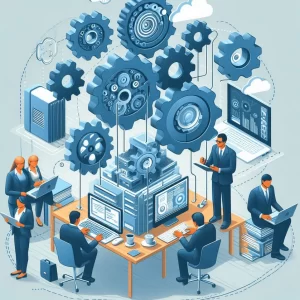Retail Store Operations Meaning & Management Guide
Table of Contents
As a small business owner, there’s a good chance you’re feeling overwhelmed by the number of tasks you need to do to achieve your business goals. After all, checking inventory, choosing display layouts, meeting with vendors, making employee schedules, arranging group training sessions, and carrying out payroll are likely among your day-to-day operations.
And, as e-commerce continues to grow, you need to make sure you’re maintaining stellar on-site operations to keep customers coming back to your brick-and-mortar store.
The good news is we’ve written this guide to introduce you to the essentials of retail operations, and we’ll cover:
- What retail operations entail
- What day-to-day tasks retail operations includes, with actionable strategies
- What you should look for in a retail operations manager
What are retail operations?
Retail operations are the day-to-day functions that keep your small retail business running. If your business is new, then retail operations might include choosing your store location and design. Once your store is looking bright, shiny, and ready to welcome customers, you’ll want to focus on hiring a retail team you can rely on.
The more your business expands, the more operations you’ll have to carry out in order to keep things running smoothly. Think of operations as the set of systems and processes you rely on to prevent problems — like managing your supply chain to prevent shelves from sitting empty or goods from being damaged.
Retail operations examples
Managing your retail operations requires juggling multiple responsibilities and switching between different types of tasks, but knowing how to design your daily workflow for efficiency can help to take the stress out of it. Let’s get into some examples of retail operations and the role they play in your business.
Store design & development
After signing your lease, designing your store layout will be your first priority. This is your chance to make sure your store is customer-friendly and designed to showcase your products.
- Organize your layout according to what you want to showcase: For example, what lighting do you want to use? Do you have signs to advertise a certain product line or guide customers toward specific promotions?
- Always consider the customer experience: When choosing your store aesthetic and layout, think about how customers will experience your store. For instance, consider what they’ll reach for first and what elements will attract their attention as soon as they walk through the front door.
Store layout and design may change as you scale your business, and it may even become more specialized. When it comes to operational efficiency, flexibility is key — you have to be willing to adapt your floor plan to meet the needs of your retail business.
Hiring & employee management
Current research shows that at least half of front-line retail workers are thinking of leaving their jobs due to a lack of flexibility and control over their duties, so retail operations managers should think about ways to optimize the hiring and employee experience for today’s retail workforce. And while the retail environment is not a traditionally flexible one, there are ways to get creative with the people management process.
- Be open to re-structuring the way your employees work: With the growing popularity of the gig economy, some large retailers have adopted this format and let their employees choose what they want to do every day, whether it’s working the register, stocking shelves, or talking to customers.
- Offer opportunities for advancement: A recent McKinsey survey revealed that career advancement is extremely important to front-line retail workers, so operations managers should think about how to make development paths possible for their staff.
- Attract and recruit the right candidates: By creating an employee-friendly environment with flexibility and development, your job description is going to attract the best candidates. That’s when it’s time to use an all-in-one solution like Homebase to help you create job posts.
- Streamline the hiring process: A good hiring tool lets you keep track of all your candidates in one place and schedule interviews with them. Streamlining operations in this way can help you focus on multiple areas of your retail venture at once. The best part? With Homebase, it can all be done without paperwork.
Inventory management
For retail operations managers, keeping your inventory coordinated and flowing is probably one of the biggest parts of the job. But maintaining inventory is a balancing act because you’re always trying to anticipate customer demand and avoid stocking too much.
You don’t have to reinvent the inventory management wheel — there are many tried-and-tested methods for keeping control of your stock:
- Perpetual inventory management: This is the simplest form of inventory management that involves counting inventory as it arrives, but stores that use barcode scanners and radio-frequency identification (RFID) tags can automate this process.
- ABC analysis: This technique involves separating inventory into 3 categories with A as the most valuable inventory with the most impact on profit, and C as the least valuable and the least impact on profit.
- Just-in-time inventory management: You can use this technique and order inventory only when you need it to avoid accumulating too much back stock.
- Safety stock inventory: Safety stock is extra stock that is ordered to set aside to avoid running out of those items.
- FIFO and LIFO: You might use the “first in, first out” (FIFO) system if you need to sell the older inventory first, and the “last in, first out” (LIFO) system works best for inventory with a shorter shelf life that needs to be sold quickly before it expires.
- Reorder point formula: This formula helps you calculate the minimum amount of stock you need before it’s time to re-order, and it depends on your average daily sales, your delivery time, and safety stock.
Transaction processing
Transaction processing includes the processes, equipment, and software that makes customer transactions possible. It can be low-tech solutions like pen and paper or high-tech solutions like transaction processing software that works together with your store’s POS system.
Most retailers rely on POS systems to help them with their transaction processing because it removes the need for storing product information on a spreadsheet. For example, without a POS system to store product numbers, a cashier would have to refer to a piece of paper to find the price for every product.
Retail business owners can also use an accounting transaction processing system (TPS) to record payroll and employee data, but you can also use our platform to organize key areas of team management in one place that helps you keep a record of everything from onboarding to time tracking.
Marketing
Local business marketing is all about getting the word out about your products. Marketing increases your reach beyond your existing customer base and helps you reach more potential shoppers, and as an operations manager, here are some marketing strategies you can set up to attract more customers to your store.
- Build a following on social media: Tap into the power of Facebook, Instagram, and even TikTok to provide value to your followers and create excitement around your products. For example, if you sell hiking and camping equipment, you can create posts and stories about what products are best for staying hydrated during a summer camping excursion.
- Take advantage of local SEO: Use Google My Business to make sure your store’s website shows up on local SEO searches, and use local keywords and hashtags — like “organic markets in Houston”—to drive more online traffic to your site.
- Take part in local events: Introducing yourself to the community at a local event like a farmer’s market, crafts fair, or retail conference can help local customers connect to your brand.
Workplace culture cultivation
Once you’ve hired great employees, create a work environment that keeps team members invested in the culture and encourages them to stick around. A great way to do this is by letting your employees know you value and respect them.
Here are some culture fundamentals you should foster for your team:
- Be intentional about listening to employee needs and taking action on their feedback.
- Organize team-building exercises that encourage employees to demonstrate their ability to problem-solve, get to know each other, and work together as a team.
- Think of special rewards and bonuses for birthdays, anniversaries, and great performance.
- Regularly recognizing good work and calling it out.
What to look for in a retail operations manager
Retail operations management isn’t just about managing systems and people — it’s about functioning under pressure and making decisions on the fly as issues arise. This takes both skill and experience to master, so here are some qualities and qualifications you should look for in a retail operations manager.
Pay & experience
Typically, retail operations manager candidates should have experience leading a team and at least five years of work in the retail industry, as well as at least a couple of years in a supervisor position. They should have a background in assisting with various aspects of store operations like inventory and scheduling.
The average retail operations manager salary is around $50,000 in the US.
Qualifications
A retail operations manager needs to demonstrate that they can lead a team to achieve their store’s retail goals while cultivating a culture that motivates and nurtures employees.
Most importantly, retail operations managers should love what they do. Their love for their job will be contagious to their colleagues and give them confidence in your decision-making. They’ll also need to be a great leader — and that means leading from the front, lending a helping hand, and listening when issues arise.
Where to find retail managers
Once you know the qualifications and leadership qualities you’re looking for in a manager, here are some strategies you can use to source great candidates for your retail operations role.
- Reach out to your local network: Use Linkedin and your store’s social media pages to advertise your open position.
- Train and promote from within: Your store associates already have the in-depth knowledge of your products and processes — they may only need to upskill in certain areas!
- Use Homebase hiring to post your open retail operations position on multiple job sites at once: With Homebase, you can also promote your job posts using paid boosts if you need to find somebody fast. Once you have a few top picks in mind, use screener questions like the ones below to choose your top candidates.
- What’s one of the biggest challenges you faced in your previous role and how did you handle or overcome that challenge?
- How do you decide which tasks to prioritize on a busy shift?
- What are your salary expectations for this role?
3 ways to optimize your retail store operations
Running a retail business requires a human touch, and optimizing your store operations means having more time to invest in your team and your customers.
1. Team communication
Great communication is one of the key drivers behind a successful business, and as a retail manager, you’ll regularly communicate with your team to discuss schedules, store promotions, and even new product launches.
That’s why Homebase team communication has a built-in chat feature to keep you and your employees talking. If a team member calls in sick, you can use the app to find someone to cover. Besides that, you can use the app to share ideas, prevent issues, share ideas and prevent issues, and encourage healthy communication between employees.
2. Optimize management
Management is another area you can optimize to keep your retail business in tip-top shape. That means hiring the right operations manager, creating the best people management practices, and using people management software to streamline the process
But owners of new or growing retail stores often don’t have time to create repeatable systems for hiring and onboarding new employees, which means they’re making it up as they go and waiting for day one to read through welcome packets, sign necessary employee documents, and training on the job.
With Homebase hiring and onboarding, you can automate your people management from the moment you publish your initial job post to the moment you’ve finished training your new front-end leader. Our app also lets new hires self-onboard, e-sign documents, and flip through employee handbooks as soon as they get the job so you can hit the ground running.
3. Retail team scheduling
Schedule mishaps and communication breakdowns can lead to a lot of problems down the road. The last thing you want is a staff shortage because an employee didn’t know they were supposed to be at work, or you didn’t realize another team member was on vacation.
All in all, scheduling gets complicated and time-consuming quickly, so having a solution in place that keeps it fast and simple is essential.
For instance, Homebase scheduling lets you share employee schedules instantly. You can edit them in real-time to accommodate any last-minute changes, and team members will be notified immediately by text, email, and in the app.
Optimize operations at every level of your retail business
Retail operations are never static. From hiring the right manager to give your team a boost to scheduling employees who work well together, you need great tools at your disposal to keep your day-to-day operations running smoothly.
Homebase helps you hire, schedule, communicate with, and pay your employees. You can use it to recruit the best managers, foster a great team spirit, and maintain streamlined communication across all your departments and staff.
FAQs about retail operations
What’s the role of operations management in retailing?
The role of operations management in retailing involves managing all the day-to-day operations needed to run and scale a retail business. That includes the processes you need to
- Run your store, both physical and online.
- Manage your team, from scheduling to payroll.
- Take charge of logistics in order to supply products at the best value for yourself, the supplier, and the customer.
What experience is needed for a career in retail operations management?
To pursue a career in retail operations management, you’ll need experience working in the retail industry for at least five years, and around three years of supervisory experience. You’ll also have to understand the particular needs and goals of a retail business, demonstrate leadership qualities, and have in-depth knowledge related to managing retail and team-based operations.
How can Homebase help with retail operations?
Homebase can help with retail operations by giving you the tools you need to manage your retail team operations in one convenient place. With our tools, you can manage employee time tracking, team communication, new hire onboarding, and general scheduling with just a few clicks. Best of all, you can run everything from our mobile app.
If you want to experience Homebase’s tools for yourself, why not sign up for a free plan?






